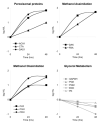SILAC compatible strain of Pichia pastoris for expression of isotopically labeled protein standards and quantitative proteomics
- PMID: 21942632
- PMCID: PMC3361967
- DOI: 10.1021/pr200551e
SILAC compatible strain of Pichia pastoris for expression of isotopically labeled protein standards and quantitative proteomics
Abstract
The methylotrophic yeast Pichia pastoris is a powerful eukaryotic platform for the production of heterologous protein. Recent publication of the P. pastoris genome has facilitated strain development toward biopharmaceutical and environmental science applications and has advanced the organism as a model system for the study of peroxisome biogenesis and methanol metabolism. Here we report the development of a P. pastoris arg-/lys- auxotrophic strain compatible with SILAC (stable isotope labeling by amino acids in cell culture) proteomic studies, which is capable of generating large quantities of isotopically labeled protein for mass spectrometry-based biomarker measurements. We demonstrate the utility of this strain to produce high purity human serum albumin uniformly labeled with isotopically heavy arginine and lysine. In addition, we demonstrate the first quantitative proteomic analysis of methanol metabolism in P. pastoris, reporting new evidence for a malate-aspartate NADH shuttle mechanism in the organism. This strain will be a useful model organism for the study of metabolism and peroxisome generation.
Figures




References
-
- Cregg JM, Vedvick TS, Raschke WC. Recent advances in the expression of foreign genes in Pichia pastoris. Biotechnology (N Y) 1993;11(8):905–10. - PubMed
-
- Cereghino JL, Cregg JM. Heterologous protein expression in the methylotrophic yeast Pichia pastoris. FEMS Microbiol Rev. 2000;24(1):45–66. - PubMed
-
- Macauley-Patrick S, Fazenda ML, McNeil B, Harvey LM. Heterologous protein production using the Pichia pastoris expression system. Yeast. 2005;22(4):249–70. - PubMed
-
- Jacobs PP, Geysens S, Vervecken W, Contreras R, Callewaert N. Engineering complex-type N-glycosylation in Pichia pas toris using GlycoSwitch technology. Nat Protoc. 2009;4(1):58–70. - PubMed
-
- Whittaker JW. Selective isotopic labeling of recombinant proteins using amino acid auxotroph strains. Methods Mol Biol. 2007;389:175–88. - PubMed
Publication types
MeSH terms
Substances
Grants and funding
LinkOut - more resources
Full Text Sources

